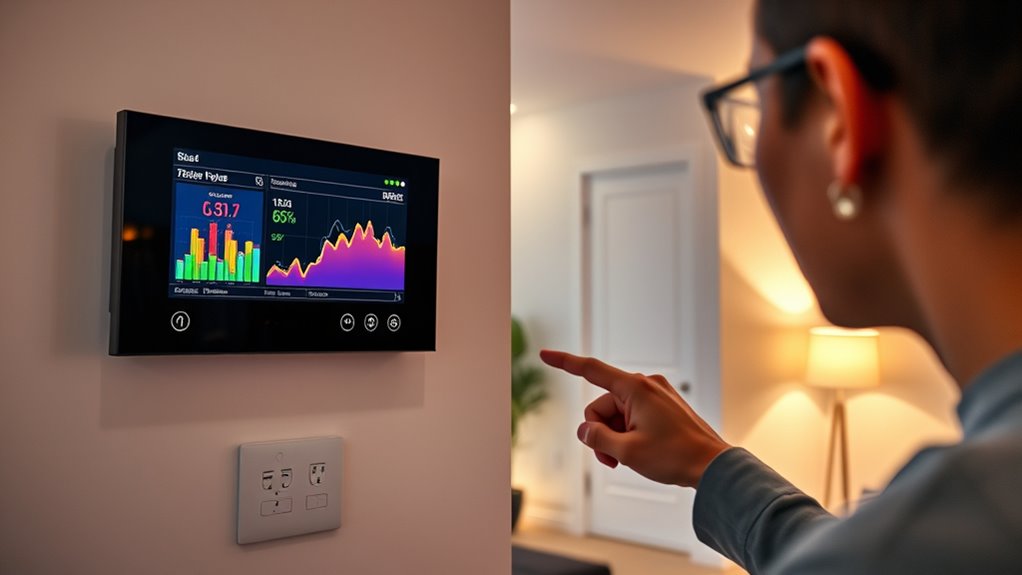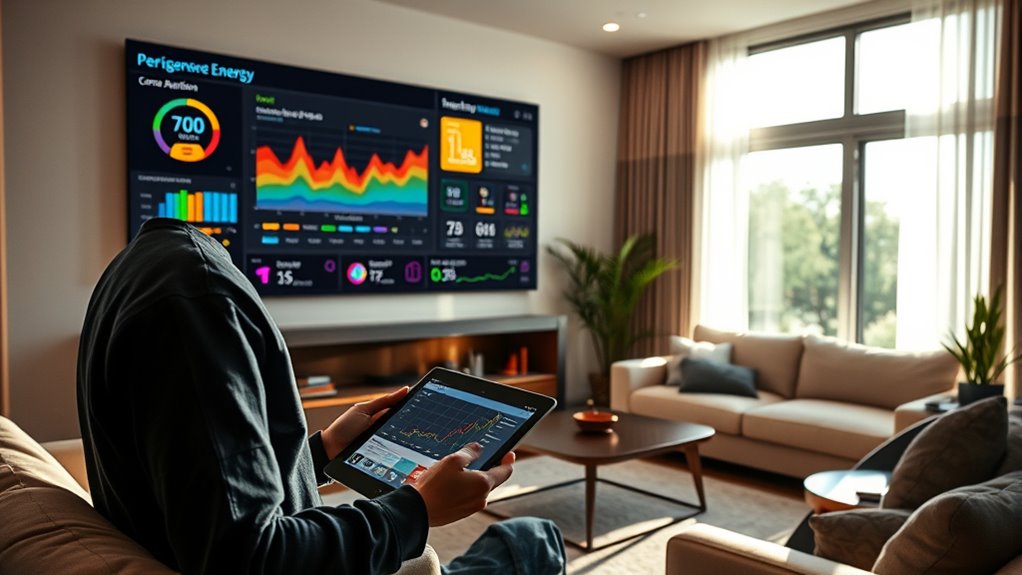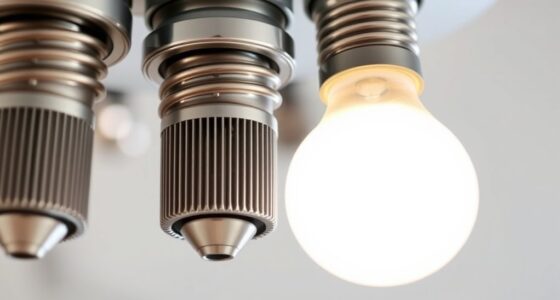Whole-home energy monitors show you detailed data about your household’s power use, revealing when, where, and how appliances consume energy. This data helps you spot high-energy devices, recognize daily and seasonal patterns, and identify hidden drains like standby power. By tracking changes over time, you can see how your habits impact costs and find opportunities for upgrades or renewable energy. Keep exploring to uncover how to use this data for smarter, more efficient home energy management.
Key Takeaways
- Identifies high-energy appliances and systems, highlighting areas for efficiency improvements and cost savings.
- Reveals daily, weekly, and seasonal usage patterns, enabling optimized energy management.
- Detects hidden energy drains like phantom loads and faulty wiring to prevent waste and reduce costs.
- Tracks behavioral impacts on energy consumption, supporting sustainable routines and peak demand management.
- Supports renewable energy integration by pinpointing peak usage times and high-consuming appliances for better planning.
Understanding How Whole-Home Energy Monitors Work

Whole-home energy monitors work by continuously measuring the electricity usage of your entire house in real-time. They rely on sensors installed on your electrical panel, which must be properly calibrated to ensure accurate readings. Sensor calibration is essential because it fine-tunes the device to match your home’s specific electrical system, preventing discrepancies in data. Proper calibration procedures are often provided by the manufacturer and may involve adjusting settings or performing a test run to verify accuracy. As you install and use a monitor, you’ll want to consider data privacy; reputable systems encrypt your usage data, protecting it from unauthorized access. This encryption helps ensure your data privacy remains intact and secure from potential breaches. Additionally, some monitors support breakdown of individual circuits, allowing for more detailed insights into specific appliances or areas of your home. The monitor processes the data locally or uploads it to a cloud platform, giving you insights into your overall energy use. Understanding the fundamentals of energy monitoring can help you interpret the data more effectively and make informed decisions about your energy consumption. For example, knowing how Sensor calibration impacts data accuracy allows users to troubleshoot issues more effectively. Moreover, understanding the types of sensors used can help you select a system that best fits your needs. By understanding these fundamentals, you can better appreciate how your energy monitor provides accurate, secure, and useful information.
Identifying High-Consumption Appliances and Systems

To reduce your energy bills, start by spotting which appliances use the most power. Analyzing your usage patterns helps you identify energy guzzlers and when they run most often. With this information, you can prioritize efficiency upgrades to save money and improve your home’s overall energy performance. Incorporating data-driven strategies can further optimize your energy management efforts. Understanding metrology and how to interpret energy data empowers you to make more informed decisions about your energy consumption, enabling you to leverage power monitoring technology effectively in your home. Developing a framework for ongoing monitoring can help maintain and improve your energy efficiency over time, especially by recognizing patterns in energy consumption of appliances.
Spotting Energy Guzzlers
Identifying high-consumption appliances and systems is essential for effective energy management, as these “guzzlers” often account for a significant portion of your household’s energy use. Whole-home energy monitoring helps you pinpoint which devices are consuming the most power, so you can target them for efficiency improvements. Be aware of potential energy theft, where unauthorized use or faulty wiring can inflate your utility billing without your knowledge. Spotting these energy hogs allows you to reduce waste and prevent unnecessary costs. By analyzing real-time data, you can see exactly when and how much each appliance uses, giving you the insight needed to make smarter choices. Encouraging a creative approach to problem-solving can help identify innovative ways to reduce energy consumption further. Cutting down on high-consumption devices not only saves money but also supports a greener, more sustainable home.
Analyzing Usage Patterns
By examining the real-time data from your energy monitor, you can uncover patterns in how and when your appliances draw power. Proper appliance labeling helps you identify which devices consume the most energy and when they operate most frequently. You’ll notice that some systems, like HVAC or water heaters, have usage spikes that may correspond with weather impact—colder or hotter days often increase their activity. Tracking these patterns allows you to pinpoint high-consumption appliances and understand their contribution to your overall energy use. Recognizing these habits helps you target specific areas for efficiency improvements and plan usage to reduce costs. Regularly assessing and adjusting your system settings can further enhance efficiency and reduce unnecessary energy use. Additionally, understanding usage patterns can inform smarter scheduling to avoid peak demand periods and save energy, especially when combined with energy-efficient practices. Monitoring these trends also provides valuable insights into potential system upgrades, enabling you to make informed decisions about optimizing your energy consumption and leveraging sound design principles to create more efficient and user-friendly home automation interfaces.
Prioritizing Efficiency Upgrades
Focusing on efficiency upgrades starts with pinpointing which appliances and systems consume the most energy. Your whole-home data will reveal these high-consumption areas, helping you target improvements effectively. Once identified, you can prioritize upgrades like replacing old HVAC systems, upgrading lighting, or installing energy-efficient appliances. Many utility rebates and solar incentives are available for such upgrades, making them more affordable. These programs often provide rebates or tax credits that incentivize reducing energy use and integrating renewable energy sources. Additionally, tracking your energy consumption over time can help you understand usage patterns and identify further opportunities for savings behavioral adjustments. By focusing on the biggest energy users first, you maximize savings and make the most of available financial incentives. This strategic approach ensures your investments lead to significant energy reductions while leveraging opportunities like solar incentives and utility rebates to lower costs. Incorporating energy monitoring data enables smarter decisions and continuous improvements in your home’s efficiency. Being aware of your overall energy consumption helps you develop a comprehensive plan for ongoing efficiency improvements. Understanding energy-efficient practices can further enhance your efforts and sustain long-term savings. Moreover, analyzing detailed energy data can uncover hidden inefficiencies and guide targeted interventions.
Recognizing Patterns in Daily Energy Use

Understanding daily energy patterns is essential for optimizing your home’s energy use. By analyzing your energy data, you can identify how occupancy patterns influence consumption. For example, mornings and evenings often see spikes as people wake up or return home, while midday might be quieter. Seasonal variations also impact your energy habits, with increased heating in winter or cooling in summer altering your overall use. Recognizing these patterns helps you anticipate when your energy demand peaks and adjust accordingly. You might notice weekends or specific days have different profiles, reflecting your lifestyle. Tracking these trends allows you to fine-tune your routines, reduce waste, and save money. The key is to use the data to understand when and why your energy use varies daily and seasonally, including energy consumption patterns that can be influenced by various factors.
Detecting Hidden Energy Drains and Inefficiencies

Hidden energy drains can quietly boost your bills without you noticing, so it’s important to identify phantom loads. By monitoring your devices, you can spot which ones are wasting energy even when they’re off. Addressing these inefficiencies helps you save money and improves your home’s overall energy use. Regularly checking for energy-wasting devices can prevent unnecessary consumption and optimize your household’s efficiency. Additionally, understanding how hydrogen fuel cells work can inspire alternative ways to power your home sustainably. Incorporating smart home technology can further help you detect and manage these hidden energy drains effectively.
Identifying Phantom Loads
Have you ever wondered if your home is wasting energy without you realizing it? Phantom loads, or standby power, are hidden energy drains from devices that remain plugged in but aren’t actively in use. These small, continuous power draws add up over time, increasing your energy bills unnecessarily. Whole-home energy monitoring helps you identify these phantom loads by showing you which devices consume power even when turned off. Look for patterns indicating consistent standby power usage, especially from chargers, entertainment equipment, and appliances with digital displays. Once you spot these hidden drains, you can take action—unplug devices when not in use or switch to smart power strips. Eliminating phantom loads is an effective way to improve your home’s energy efficiency and reduce waste.
Spotting Inefficient Devices
To spot inefficient devices, you need to look for signs that certain appliances are consuming more energy than they should be. For example, a smart thermostat that isn’t calibrated properly may cause your HVAC system to work harder than necessary, wasting energy. Check your energy data for unexpected spikes during specific times; these often point to inefficient devices. If you have solar panels, monitor their output versus your energy consumption. A decline in solar efficiency might mean appliances aren’t operating at their best or there’s hidden drain. Use your energy monitoring system to identify appliances that run longer or use more power than expected. Recognizing these patterns helps you target inefficient devices, reduce waste, and maximize overall energy use in your home.
Tracking Changes in Usage Over Time

Ever wonder how your energy usage fluctuates throughout the day or week? Monitoring these changes helps you understand your energy consumption patterns. By tracking usage trends over time, you can identify when your home consumes the most power and spot unexpected spikes. This insight allows you to adjust habits, optimize appliance use, and improve efficiency. For example, you might notice higher consumption during weekends or evenings, prompting you to shift certain activities. Consistently analyzing your data reveals seasonal shifts or irregularities that could indicate issues or opportunities for savings. Over time, this ongoing tracking empowers you to make informed decisions, reduce waste, and lower your energy bills. Staying aware of your usage patterns ensures you’re always in control of your home’s energy efficiency.
Comparing Energy Consumption Across Different Times of Day

Understanding how your energy use varies at different times of day can reveal valuable insights into your household’s habits. By conducting a time-based analysis, you can identify patterns in your daily consumption.
Here are four key points:
- Peak hours often occur in the mornings and evenings when appliances and heating are in high use.
- Midday consumption may drop, indicating less activity or energy-efficient habits.
- Nighttime usage can highlight standby power or late-night appliances.
- Comparing these patterns helps you optimize energy use, reduce costs, and adjust habits accordingly.
Tracking daily consumption across different times of day allows you to pinpoint when your home consumes the most energy and where improvements can be made. This targeted approach helps you make smarter decisions about energy efficiency.
Evaluating the Impact of Behavioral Changes

Monitoring how your energy consumption changes after making behavioral adjustments allows you to see what really works. By tracking these changes, you can identify which lifestyle adjustments lead to meaningful savings and increased efficiency. Behavioral motivation plays a key role—you’re more likely to stick with habits that show clear results. For example, turning off unused appliances or adjusting thermostat settings can markedly reduce energy use. Whole-home energy monitoring provides real-time feedback, helping you understand the impact of your actions. This data encourages you to refine your habits and stay motivated. Ultimately, evaluating these behavioral changes helps you develop sustainable routines that cut costs and lessen your environmental footprint without sacrificing comfort.
Estimating Cost Savings From Improved Efficiency

To estimate your cost savings, start by identifying which appliances consume the most energy. Next, calculate how much you could save by upgrading or changing usage habits for those high-demand devices. This will help you determine the return on investment for efficiency improvements and prioritize your efforts.
Identifying High-Consumption Appliances
Identifying high-consumption appliances is a crucial step in estimating potential savings from improved efficiency. By pinpointing which devices use the most energy, you can target efforts effectively. Consider these key points:
- Use your energy monitor to track appliance usage and identify those with the highest consumption.
- Focus on appliances with short or aging appliance lifespan, as they often consume more energy.
- Check maintenance schedules; neglected appliances tend to operate inefficiently and waste power.
- Prioritize replacing or upgrading appliances that are costly to run and nearing the end of their lifespan.
Calculating Return on Investment
Once you’ve pinpointed the high-energy-consuming appliances, the next step is to estimate how much you can save by making improvements. Focus on potential energy bill reduction and appliance lifespan extension. To do this, consider the costs of upgrades versus the savings. Here’s a simple way to visualize the potential benefits:
| Appliance | Estimated Annual Savings | Cost of Improvements |
|---|---|---|
| HVAC System | $150 | $1,200 |
| Water Heater | $80 | $500 |
| Refrigerators | $50 | $300 |
| Lighting Upgrades | $40 | $200 |
This table helps you estimate ROI, making it easier to decide if upgrades are worthwhile based on potential savings and improved efficiency.
Discovering Opportunities for Renewable Energy Integration

By analyzing your entire home’s energy usage, you can uncover key opportunities to incorporate renewable energy sources effectively. This helps with solar integration and enhances your renewable planning. Here are four ways to identify these opportunities:
- Spot high-energy-consuming appliances that could benefit from solar power.
- Determine peak usage times to optimize solar panel placement.
- Assess seasonal variations to plan for supplemental renewable sources like wind or solar.
- Identify areas where energy efficiency improvements can complement renewable systems.
With this data, you can make informed decisions, maximize your solar investment, and ensure your home’s energy future aligns with sustainability goals. Whole-home monitoring reveals exactly where renewable energy can make the biggest impact.
Using Data to Make Smarter Home Energy Decisions

Harnessing the detailed data from whole-home energy monitoring allows you to make smarter, more informed decisions about your energy use. With this data, you can optimize your consumption, leverage a smart grid, and plan for energy storage. For example, you might shift high-energy tasks to off-peak times or utilize stored energy during peak hours. Understanding your energy patterns helps you identify inefficient appliances and reduce waste. Incorporating energy storage enables you to store excess renewable energy or grid power, increasing independence and savings. Use the table below to visualize key decision points:
| Action | Benefit |
|---|---|
| Connect to a smart grid | Enhanced energy management |
| Invest in energy storage | Increased energy independence |
| Adjust usage based on data | Lower costs, higher efficiency |
Frequently Asked Questions
How Accurate Are Whole-Home Energy Monitors in Detecting Individual Device Consumption?
Whole-home energy monitors can be quite accurate in detecting individual device consumption, especially with good sensor accuracy. They use device differentiation techniques to identify different appliances based on their energy signatures. However, the accuracy may vary depending on the quality of sensors and the complexity of your home’s electrical system. Generally, higher-quality monitors provide more precise data, helping you better understand which devices use the most energy.
Can Energy Data Predict Future Appliance Failures or Maintenance Needs?
Yes, energy data can help predict future appliance failures or maintenance needs. By analyzing patterns and deviations, you can identify early signs of issues, enabling predictive maintenance. This proactive approach can extend your appliance lifespan, reduce unexpected breakdowns, and save costs. Regular monitoring of energy consumption gives you valuable insights, so you can schedule repairs before problems worsen and ensure your home stays efficient and reliable.
What Privacy Considerations Exist With Detailed Energy Monitoring Data?
Your energy data is like a secret garden, full of insights but vulnerable if not protected. Privacy concerns arise because detailed monitoring reveals your habits and routines. To safeguard this, data anonymization disguises identities, and user consent ensures you’re in control of what’s shared. By taking these steps, you keep your personal life private, even as you enjoy the benefits of smarter energy use.
How Do Seasonal Changes Affect Energy Consumption Insights?
Seasonal variations and weather impact profoundly influence your energy consumption insights. During colder months, you’ll notice increased heating usage, while summer brings higher cooling demands. These fluctuations can make some data appear inconsistent if not properly contextualized. By understanding how weather impacts your energy use, you can better identify patterns, optimize your system, and implement energy-saving strategies that adapt to seasonal changes, ultimately saving you money and reducing your environmental footprint.
Are There Industry Standards for Interpreting Energy Monitor Data?
You’ll find that industry benchmarks guide how you interpret energy monitor data, helping you understand typical consumption patterns. While standards vary, many organizations recommend comparing your data against these benchmarks to identify inefficiencies. For example, homes generally use about 30% of energy for heating and cooling. Using these benchmarks enhances data interpretation, ensuring you spot areas for improvement and optimize energy use effectively.
Conclusion
By harnessing whole-home energy monitoring, you gain insights as clear as a lighthouse guiding your decisions. You’ll spot high-consuming appliances, uncover hidden inefficiencies, and see how your habits impact your energy bills. With this data, you can make smarter choices, save money, and even embrace renewable energy options. Think of it as turning on a bright light in your home’s energy use — helping you navigate toward a more efficient and sustainable future.









